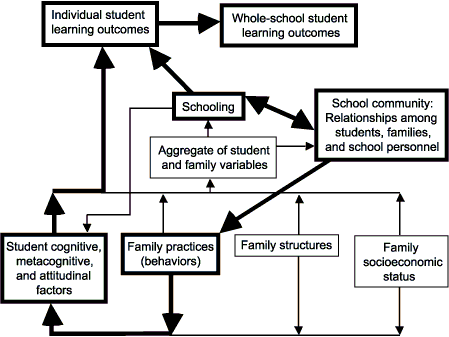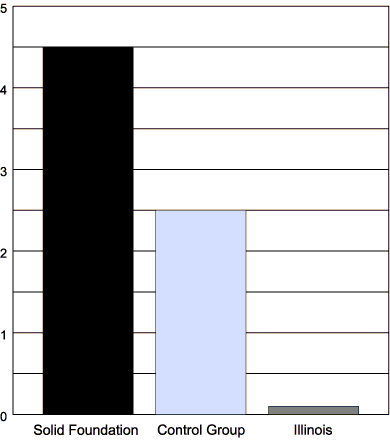The Harvard Family Research Project separated from the Harvard Graduate School of Education to become the Global Family Research Project as of January 1, 2017. It is no longer affiliated with Harvard University.
|
November 2004 The Effects of Comprehensive Parent Engagement on Student Learning OutcomesSam Redding, Janis Langdon, Joseph Meyer, Pamela Sheley |
Article Information
- Full Text (HTML)
- Full Text (PDF: 128 kb)
Research Background
While the effects of home environments on school learning are significant and well documented in the research literature, evidence that learning can be enhanced by school-based initiatives to influence family behaviors is scarce. This may be the case because parent engagement programs tend to be small in scope and scale, not focused on student learning, and primarily inclusive only of parents who choose to participate in activities at the school. Studies of whole-school effects are typically ex post facto, in the tradition of effective schools research that examines the characteristics of successful schools rather than validating the value added to learning by experimental interventions.
From the limited evidence available, Henderson and Mapp (2002) draw convincing conclusions as to the qualities that successful school's efforts to engage families might include. These qualities (such as building a foundation of trust and respect, connecting parent-engagement strategies to learning objectives, and reaching out to engage parents beyond the school) are found in schools where parent involvement is measurably high, in specific programs that demonstrate effects on learning outcomes, and in schools that exhibit high levels of achievement. Henderson and Mapp (2002) echo Swap's (1993) conclusions that effective parent engagement must be comprehensive in nature, with the school consistently interfacing with parents at many points, in many venues, over the course of the schooling years.
The school may affect home environments in positive ways with its intentional, consistent interaction with parents. Figure 1 demonstrates the student, family, and school variables that impinge upon student learning outcomes, both individual and whole school. This is a dynamic system subject to influence at every point. It can be influenced by focused and intentional interventions by the school itself, through the relationships, expectations, and opportunities for association it creates within the community of those intimately attached to it. “School community: Relationships among students, families, and school personnel,” as designated in a box on the right in Figure 1, is the vehicle through which the school, through its policies and practices, can exert influence on family behaviors linked to school learning. That same box also holds the reservoir of human and social capital that may be turned to influencing and improving the school itself. Thus, the connection between “schooling” and the “school community” in the figure is one that applies pressures in both directions.
Figure 1. Relationships among student, family, and school variables and their effects on student learning outcomes. Bold lines show path of malleable variables the school can affect to improve student learning outcomes.

The Study
This study examined the school-level effects on tested student achievement in 129 high poverty elementary schools that implemented a common set of comprehensive parent-engagement strategies over a 2-year period. The strategies included
- Parent participation in decision making at the school
- Alignment of the school's policies and procedures regarding homework and parent-teacher conferences with rubrics of research-based practices
- Explicit discussion of the roles of parents, teachers, and students around compacts, learning standards, and homework policies
- Reading school-home links aligned with state standards and in-class instruction
- Parent education focused on home reading and study habits
- Outreach through home visits, family nights, and a family resource library
Because the set of strategies was successfully implemented with little variability among the subject schools, comparison of effects on student learning outcomes (state assessment tests) were made with the state as a whole and with a series of multiple, statistical matches with control groups of schools with identical beginning test scores. The project schools demonstrated average gains on state assessment tests that significantly exceeded the average gains of all schools in the state and of multiple, statistical matches with schools with identical beginning test scores.
The study was designed to answer three questions:
- Was implementation of the program acceptably uniform across the 129 schools to make this set of schools distinct?
- Did this set of schools demonstrate significant gains on the Illinois Standards Assessment Test (composite score) between 2001 and 2003?
- Did this set of schools demonstrate gains on the Illinois Standards Assessment Test (composite score) between 2001 and 2003 that were significantly greater than (a) all elementary schools in the state, and (b) 1,000 statistical control groups, each generated by a random query of the state database that found schools with 2001 composite ISAT scores matching those of the experimental group.
Research Methods
The 129 schools in this study became part of the Solid Foundation program because their districts were included on the Illinois State Board of Education's list of districts with low assessment scores in reading. Typically, the schools were in urban or remote rural settings. They were scattered from one end of the state to the other. As Table 1 demonstrates, the students served by these schools were disproportionately poor and were members of ethnic minorities.
Table 1. Students Served by Schools in Study
| Total Enrollment | % Poverty* | % White | % African American | % Hispanic | % Other |
| 42,663 | 68.1 | 38.4 | 48.1 | 11.9 | 1.8 |
* Free or reduced-price lunch
The Solid Foundation model included 12 components, and each school's implementation of the components was measured. All the schools successfully implemented the 12 components to an extent that made differentiation among the schools based on the level of implementation impossible. Therefore, the schools were studied as a group, all of which had met a threshold of successful program implementation. A statistical control group of non-implementing schools was created by conducting a computer search of the database of all schools in the state and matching each project school with a school with an identical base-year composite assessment score. This random match was conducted 1,000 times, and the group mean of the 2-year gain on the ISAT was compared with that of the mean for project schools.
Research Findings
Question 1: Did the 129 schools improve?
The Solid Foundation schools moved from 51.3% in 2001 to 55.8% of students meeting state expectations on the composite state assessment score in 2003, a difference that was statistically significant as determined by a t-test comparing the means of the groups (see Table 2).
Table 2. Solid Foundation Schools: Percent of Students Meeting or Exceeding State Expectations on the Illinois Standards Assessment Test (ISAT)
| 2001 Mean | 2003 Mean | Mean Diff. (Gain) | Std. Dev. | Std. Error Mean | t | Sig. (2-tailed) | |
| 2003–2001 (N = 129) | 51.38% | 55.88% | 4.50 | 10.830 | .954 | 4.723 | .000* |
* T-test of paired samples
Question 2: Was this change significantly different from change among all schools in the state?
All schools in the state advanced from 63.8% in 2001 to 63.9% in 2003 of students meeting state expectations on the composite state assessment test, a gain of .1% compared with the project schools' gain of 4.5%, as demonstrated in Table 3.
Table 3. Solid Foundation Schools and All Elementary Schools in State: Percent of Students Meeting or Exceeding State Expectations on the Illinois Standards Assessment Test (ISAT)
| ISAT 2001 | ISAT 2003 | Gain | |
| Solid Foundation Schools (N = 129) | 51.3% | 55.88% | 4.5% |
| All elementary schools in state (N = 3061) | 63.8% | 63.9% | .1% |
Question 3: Was this change significantly different from change in a statistical control group?
From 2001 to 2003, the 129 Solid Foundation schools realized a larger average increase in the percentage of students meeting or exceeding state expectations on the ISAT than 99.99% of 1,000 control groups generated by the random, statistical match with beginning-year ISAT scores. While the Solid Foundation schools enjoyed a 4.5% increase in test scores, the control group moved from 51.3% to 53.8% during the same period, while all elementary schools in the state moved from 63.8% to 63.9%. As Table 4 illustrates, the difference in the gains of the two groups was statistically significant.
Table 4. Solid Foundation Schools and Statistical Control Group: Percent of Students Meeting or Exceeding State Expectations on the Illinois Standards Assessment Test (ISAT)
| ISAT 2001 | ISAT 2003 | Gain | Sig. | |
| Solid Foundation Schools (N = 129) | 51.3% | 55.8% | 4.5% | .001 |
| Control group (1,000 random statistical matches) | 51.3% | 53.8% | 2.5% |
Figure 2 illustrates the 2-year gains on the composite state assessment score of project schools, the statistical control group, and all schools in the state.
Figure 2. Solid Foundation Effectiveness Study Mean Difference (Gain)
From 2001–2003 in Percent of Students Meeting or Exceeding State Expectations on ISAT

Improving Practices to Engage Families in Education
In the first 2 years of implementation, Solid Foundation proved that a critical mass of constructive, school-home activity can be generated in a relatively short period of time in schools most in need of programming to engage parents in children's learning. The comprehensive nature of the intervention was itself the source of impact on learning rather than the individual parts. This conclusion is consistent with the illustration of influences on whole-school learning outcomes depicted in Figure 1. The box titled “School community: Relationships among students, families, and school personnel” would encompass all the components of Solid Foundation. In their aggregate, they exert influences in two directions: on the individual families of students and on the operation of the school itself. As parents interact with their children's schooling in different ways, at different points in time, with a consistent message as to their significance in the process, family attention to learning increases and gains a focus. As teachers enlist the support of parents in learning, in different ways at different points in time, they are reminded of the advantages of such alliances, and the child's learning increasingly becomes the focus of their interactions with parents. The cumulative effects of more frequent and higher quality interactions among teachers and parents are a greater reservoir of trust and respect, increased social capital for children, and a school community more supportive of each child's school success. Community-based organizations and schools will be most effective in engaging families in their children's education if their efforts are comprehensive, focused, and coherent.
Specifically, schools can clearly articulate their expectations of parents and regularly communicate with parents about what children are learning, suggesting what parents can do to help. School-home compacts, reading school-home links, and explicit homework policies are examples of communication about expectations and support for children's learning. Schools can also provide opportunities for parents to talk with school personnel about parents' role in their children's education through home visits, family nights, and well-planned parent-teacher conferences and open houses. Schools can provide parent education based on the role of parents in helping their children meet state learning standards. An ongoing conversation between parents and teachers about the role of each in children's learning is key to building the relationship and understanding that enhances school performance.
For more information visit the Academic Development Lab at www.adi.org or email Sam Redding at sredding@adi.org.
References
Henderson, A., & Mapp, K. (2002). A new wave of evidence: The impact of school, family, and community connections on student achievement. Austin, TX: Southwest Educational Laboratory.
Swap, S. (1993). Developing home-school partnerships: From concepts to practice. New York: Teachers' College Press, Columbia University.
Free. Available online only.
